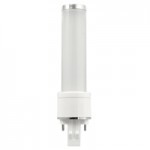LED PL lamps, specifically named for the original manufacturer, Philips Lighting, is easy on energy consumption, yet they can be a bit complicated to understand. To take the guess work of it, here are a few facts about PL lamps. 
All About the Base
PL bulbs are pin-based, with either two or four pins, and installing them requires a pin-based lighting fixture. There are many base types, like GX23, with the different names representing the pin configuration of the lamp. In order to find the right lamp for installation/replacement, check the base for details of the type, pin configuration, wattage and light color.
Lamp Brightness
The brightness level of PL lamps is determined by lumens, which measures how bright a bulb is. This is different than wattage, which measures the energy output of a lamp.
Color Temp: Warm to Daylight
PL bulbs shine in varying light colors. From warm white to daylight, the specific temperatures are:
2700k – warm white
2500k – soft white
4100k – cool white
5000k – daylight
Maximum Overall Length
Sometimes a little more information is required to properly install/replace PL lamps. Some fixtures have size limitations known as the maximum overall length (MOL). To find the length of PL bulb, measure from the base to point of the bulb.
How They Stack Up
The five- and seven-watt LED PL Lamps are available in GU24, E26 as well as GX23 and G24q pin base options to replace 13- and 18-watt compact fluorescent lamps (CFLs). LED PL lamps have up to a 50,000-hour lifetime, and deliver an 80 color rendering index (CRI) with uniform consistency compared to CFLs. The lamps operate on a 120-277 volt system to easily retrofit into a variety of residential applications, including recessed cans, sconces, and ceiling fixtures.
